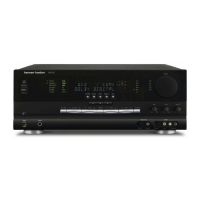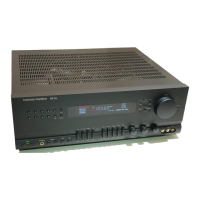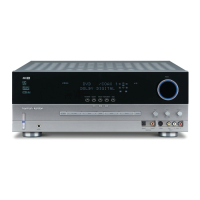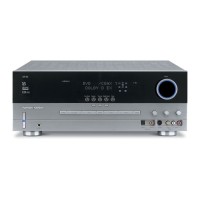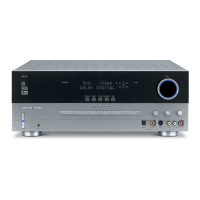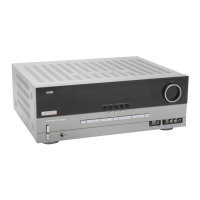52 JUNE 2001 SOUND & VISION
with every receiver we know of, the multi-
channel input signals go straight to the am-
plifier section, bypassing the bass-manage-
ment circuitry.) All this combines to earn
the AVR 510 a solid A grade for flexibility
— maybe an A+.
After introducing the receiver to my us-
ual suite of reference speakers and source
components — setting all speakers to
“small,” with bass directed to my subwoof-
er — my first order of business was to put
its EZSet auto-level-balancing gizmo to
the test. Simply hold the remote upward at
arm’s length while you’re in the main lis-
tening position, keep it steady, and hold in
its SPL (sound-pressure level) key. The re-
ceiver automatically cycles twice through
the five channels, playing level-set noise
and robotically fiddling levels up and down
while an LED on the remote changes color
from red (too loud!) or amber (too soft!) to
green (j-u-u-st right!).
The system worked very well, but with
one caveat. The final levels were all within
1 dB of those I arrived at by performing the
same task manually using my tripod-
mounted sound-level meter — pretty
darned good and considerably
better than most users could
do by ear. The caveat? While
you hold the remote at the
listening position, it must
have a clear line of sight to
the receiver for its infrared
signals. If the receiver is located well
to one side instead of being in the
front of the room, EZSet won’t
work properly — but it also won’t
give you an error message.
Harman Kardon has built a bit more
flexibility into the AVR 510 than many re-
ceivers offer, so it demands (and rewards) a
bit more planning on the part of the user.
For one thing, any of the six digital audio
input jacks — counting those on the front
as well as the back — can be assigned free-
ly to any source. For another, the receiver
remembers your surround-mode, speaker-
size, and channel-level settings individual-
ly for each assigned source.
You could, for instance, set up the DVD
input with Dolby Digital as the default sur-
round mode, “small” speakers plus a sub-
woofer, and channel levels calibrated for
movies, while leaving the CD input set up
for stereo and “large” (full-range) front
left/right speakers. These two inputs might
even be supplied by the same component
— a DVD player’s optical digital audio
output could be assigned to the DVD input
and its coaxial output to the CD input.
What’s more, each surround mode stores
its relative channel levels individually, so
you might use the calibrated balance dialed
in by EZSet for Dolby Digital while setting
the surround channels in the two Hall
modes a couple of decibels higher.
All this makes the AVR 510 highly cus-
tomizable if you’re prepared to take the
trouble. The downside is that it’s more
complex to set up, particularly since you
must set the channel levels and bass man-
agement individually for each input you
want to use.
The AVR 510 sounded excellent in both
two-channel stereo and surround modes —
and despite its relatively modest power rat-
ing of 70 watts
per channel, it
proved quite pow-
erful, too. (Remem-
ber, in terms of sound
level, the difference be-
tween 70 and 100 watts is
just a bit over 1
1
⁄
2
dB — hardly
meaningful. And the AVR 510 ex-
ceeded its rating by a generous mar-
gin anyway.)
In full-range stereo music listening,
without a subwoofer, the AVR 510 played
very loud without distortion — almost as
loud as the 150-watt-per-channel receiver
I’d been using previously. Pushed too hard,
however, it began sounding “hazy,” and
when I forced it a couple of decibels fur-
ther out, it distorted on large transients.
Performance with standard 5.1-channel
material was first-class, as on the energeti-
cally mixed (and surprisingly good) sound-
track of the
Rocky and Bullwinkle DVD
(all right, all right, so it was family night at
the Kumin residence . . .). The series of
well-done helicopter flybys at the start of
Chapter 8 were impressively tight and
smooth in both the Dolby Digital and DTS
soundtracks, as were the film’s innumer-
able sound and musical effects.
The receiver’s additional surround modes
are all variations on ambience extraction
as opposed to ambience synthesis — no ar-
tificial reverb is added. Among the most
engaging are Logic 7 M (music) and Logic
7 C (cinema), intended for stereo music
and surround-encoded TV sound or movie
soundtracks, respectively. The two are sim-
ilar, though with the music mode there was
more ambience from the surround chan-
nels. With Logic 7 M, live acoustic music
recordings were naturally spacious and vo-
cals sounded excellent in the center chan-
nel, both contributing to a consistently be-
lievable front soundstage and a restrained
but spacious surround. The music mode
did a great job on studio recordings, too.
As far as playing MP3 files, Harman
Kardon claims that the AVR 510 can con-
vert MP3 data received at any of its digital
test report
key features
●
Dolby Digital, DTS, and digital-domain
Pro Logic decoding
●
Decodes MP3 data fed to digital inputs in
standard (SPDIF) digital audio format
●
Logic 7 surround modes for music and
TV/movie sound
●
1 Theater mode, 2 Hall modes
●
Level/bass-management settings stored
separately for each surround mode
●
Decodes HDCDs
●
VMAx virtual surround for two-speaker
playback
●
Front-panel A/V and optical/coaxial digital
audio inputs; all but optical jack can be
converted to recorder outputs
●
3 A/V inputs, 2 A/V outputs on back
panel, all with S-video, 2 with component
video
●
2 optical and 2 coaxial digital audio inputs,
1 optical and 1 coaxial output on back;
can be assigned to any digital source
●
5.1-channel external analog audio input
●
2 analog audio-only inputs, 1 tape loop
●
5-channel pre-out/main-in jacks
●
Headphone jack
●
Multiroom stereo audio output and IR
control input
●
AM/FM tuner with 30 presets
●
Binding posts for all speaker outputs
●
Preprogrammed/learning main remote
control with microphone and sound-level
meter for automatic EZSet speaker
balancing; 5-macro capability
●
Simplified second-room remote control

